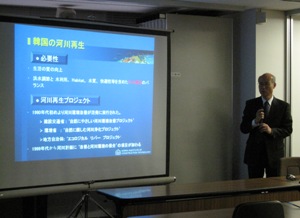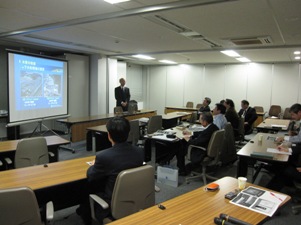Through discussions in the ARRN Technical Committee, which consists of Japanese, Chinese, and Korean experts, ARRN is collecting technical information on river environments, including the Technical Guideline for River Restoration, which should be shared among Asian countries. Dr. Naoki Shirakawa has taken up a post of an ARRN Technical Committee Member as a representative of Japan, after the former Committee Member Dr. Keigo Nakamura. The following is an inauguration message from Dr. Shirakawa.
“I have become an ARRN Technical Committee Member. I think the rivers in Monsoon Asia are characterized by variation and diversity. I will make every effort to achieve beautiful river landscapes, while preserving the particular features of the Asian sub-continent and its regional characteristics.”
By JRRN-secre | Category: News from JRRN secretariat | Comment(0) | Trackback(0) |
Date: 2009.01.27 20:49
- Dr. Lee Samhee (Korea Institute of Construction Technology)
- Date : December 10, 2008, 15:30 - 17:30
- Venue : Foundation for Riverfront Improvement and Restoration, JAPAN
On Wednesday, December 10, 2008, JRRN hosted the Second JRRN Mini-seminar on River Environments, “The Restoration of Urban Rivers Including the Anyang River” (with lecturer Dr. Lee Samhee, KICT researcher). The lecture, which was about the current situation of river restoration in Korea as well as technical methods and issues, focused on a case study of the Anyang River. In addition, there was an active exchange of opinions with participants.
In the lecture, Dr. Lee briefly introduced some approaches towards river restoration in Korea. Then, taking up the Anyang River, which is famous as a successful case of urban river restoration, he explained the outline of the restoration project, applied technologies, the current situation of ecological recovery, and participation by citizens.
There was also a one-hour exchange of opinions after the lecture. During that time, participants discussed the differences between characteristics of rivers and the legal systems of Japan and Korea, the importance of the presence of leaders in a project, and relationships among governments, citizens and business organizations in the management of river environments in Korea. This gave a precious opportunity for them to understand similarities and differences between Korea and Japan.
→>>Materials (Language: Japanese only)(PDF 1.5MB)
By JRRN-secre | Category: JRRN & ARRN's Event Report | Comment(0) | Trackback(0) |
Date: 2009.01.16 10:08




